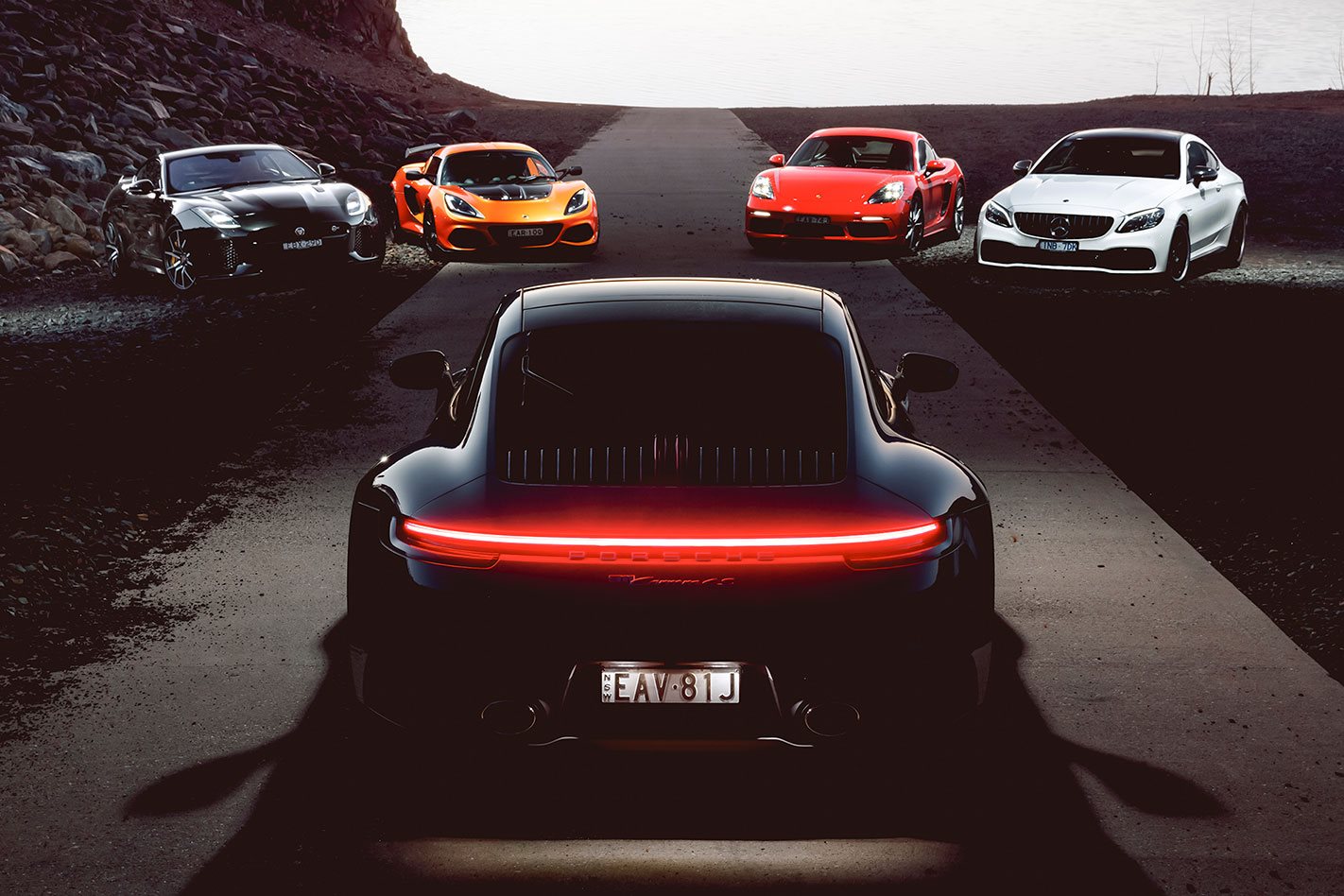THE FIVE cars move quickly across country, chasing the setting sun. The convoy stretches and compacts like a slinky spring as the road contours eastwards, climbing out of river drainages and over the rolling crests of Mount Pleasant. It doubles back and gets even twistier, the sky now imperceptibly graded shades of umber, dust filtering through the ironbarks, the cars ahead just silhouettes; cryptic outlines phasing in and out of the dazzle.
Up front is the unblinking tail-light bar of the new Porsche 911, the bunched-up bottle-rocket shape of the Jaguar F-Type SVR and there, most incongruous of all is the low and long Lotus Exige Sport 410, its high-mounted wing, extruded door mirrors and fat rear tyres looking like something from the GTE grid at Le Mans, landed here in country Australia, dodging echidnas.
I’m in a Porsche 718 Cayman, while squinting through the cloud behind is a Mercedes-AMG C63 S, its toothy grille looming out of the dust vortices like Hannibal Lecter on a gurney. We’re tired, dirty, windburnt and happy, after two days in these five coupes. While they may appear a disparate bunch, there’s a very pragmatic reason for them being here.
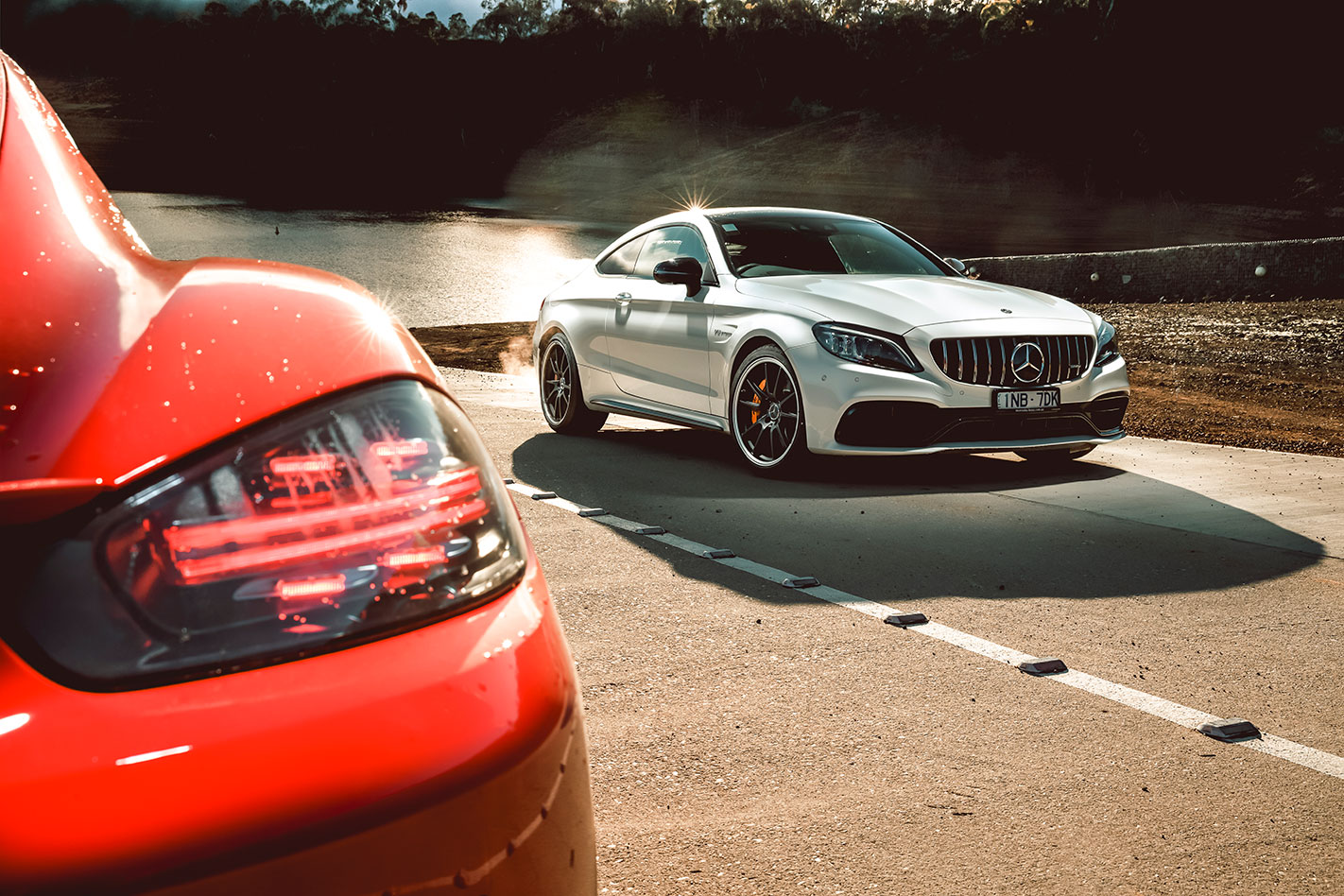
Having driven Porsche’s new 992 on Aussie soil, we’d come to the realisation that nothing would beat it head on, so we didn’t want to waste your time with that. Instead, we wondered how convincing were the alternatives if you wanted a coupe more hardcore than the 911 Carrera; or more liveable; or more affordable; or more extrovert. So that’s why we’re here, bumping along a narrow mountain road trying to cross the Black Spur before nightfall.
According to our VBOX data logger, it takes the 911 Carrera 4S just 3.4 seconds to reach 100km/h. That’s quicker than a 997 GT2 RS. It demolishes the quarter mile in 11.6s and does so with no histrionics. Switch it into Sport Plus, flex onto the brake, jab the throttle pedal to the floor and sidestep the stoppers. The Sport Chrono-equipped Porsche hooks up cleanly, sending drive to all four tyres, the eight-speed PDK transmission blat-blat-blatting up through the gears. Job done. The Cayman is similarly undramatic, beating its published 4.9sec to 100km/h by a couple of tenths. The Jaguar delivers a whole lot more drama. Foot on the brake, load up the torque converter and let it go. The combo of all-wheel drive, bellowing V8, keening supercharger and a wriggling wheel make the 3.7s to 100km/h seem even quicker. It weaves under braking from 220km/h, its more softly reined 1705kg clearly apparent.
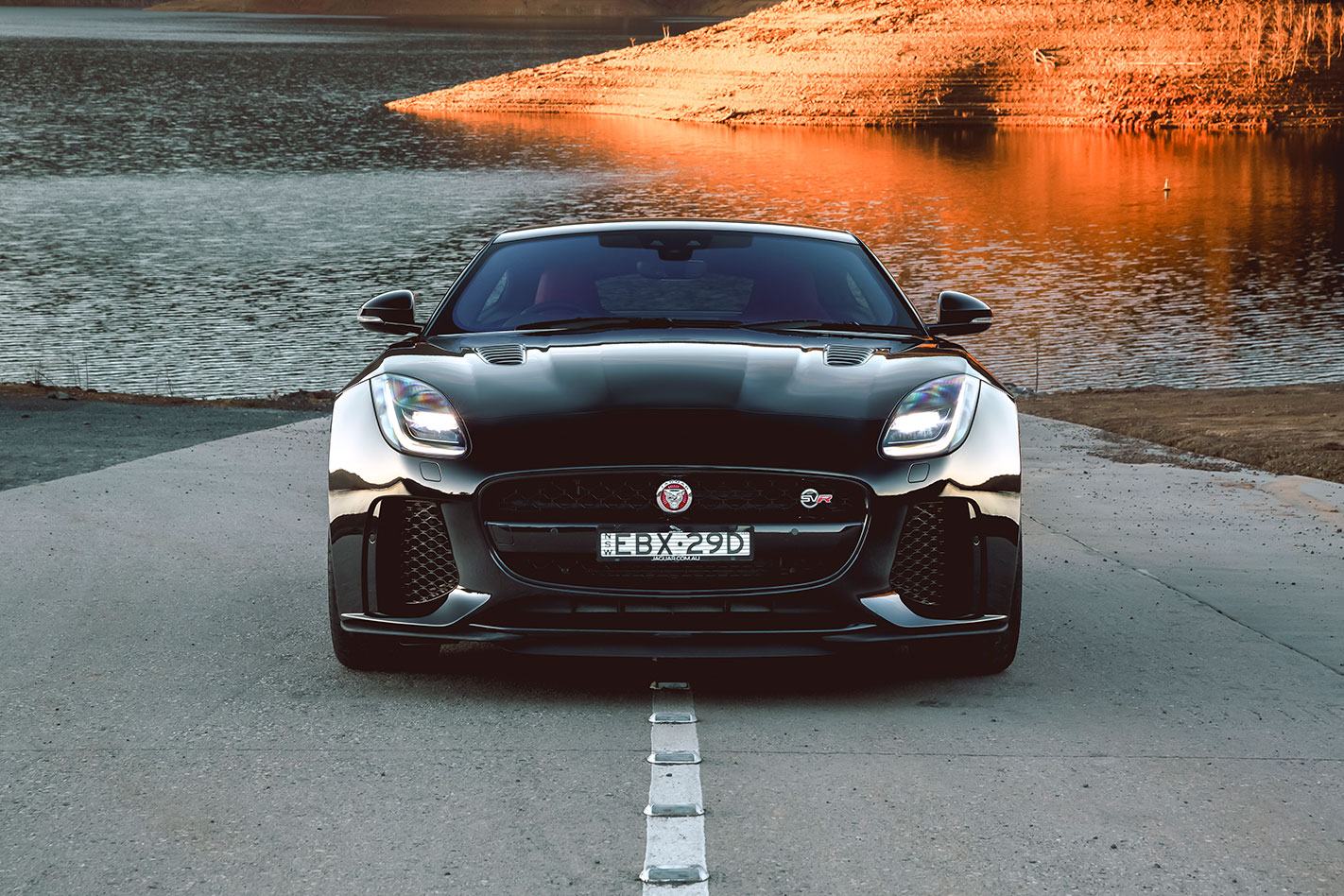
The Lotus and Mercedes require a bit more work to launch cleanly. The AMG C63 S has a sophisticated nine-stage traction control system and a Race mode. None of it helps significantly to get the car off the line, the 4.0-litre twin-turbo V8 and launch control combo flipping a coin and landing you with either unproductive wheelspin, or stabbing traction-control interventions. Try to drive it away rather than rely on the launch control and it’s just not that quick. A best of 4.4 seconds comes after multiple attempts. The least powerful car here, the 220kW Porsche 718 Cayman, would monster this 375kW Mercedes nine times out of ten away from the traffic lights.
The Exige Sport 410 is a milestone vehicle. It’s the first manual car Wheels has strapped timing gear to in our 66-year history that has ever dipped into the threes to 100km/h. In an age when we’re getting a bit blasé about the ludicrous acceleration figures of electric sports cars, that’s still a mighty achievement, especially on a day when the strip wasn’t at its grippiest. And who would have ever imagined that a Camry V6 would make the Lotus the best-sounding thing here?
Round one to the 911 then. At $281,100 before options and on-roads, the Carrera 4S is the most expensive car on this test, so it does carry a certain level of expectation. But then we have always had a certain expectation of the 911 and, aside from a blip in 2008 when the 309kW Audi R8 and the 357kW Nissan R35 GTR made the 265kW 997 Carrera S look a bit passé, it’s lived up to the billing. But where the 997 was an evolution of the 996, which first launched more than a decade earlier, the 992 is box-fresh.
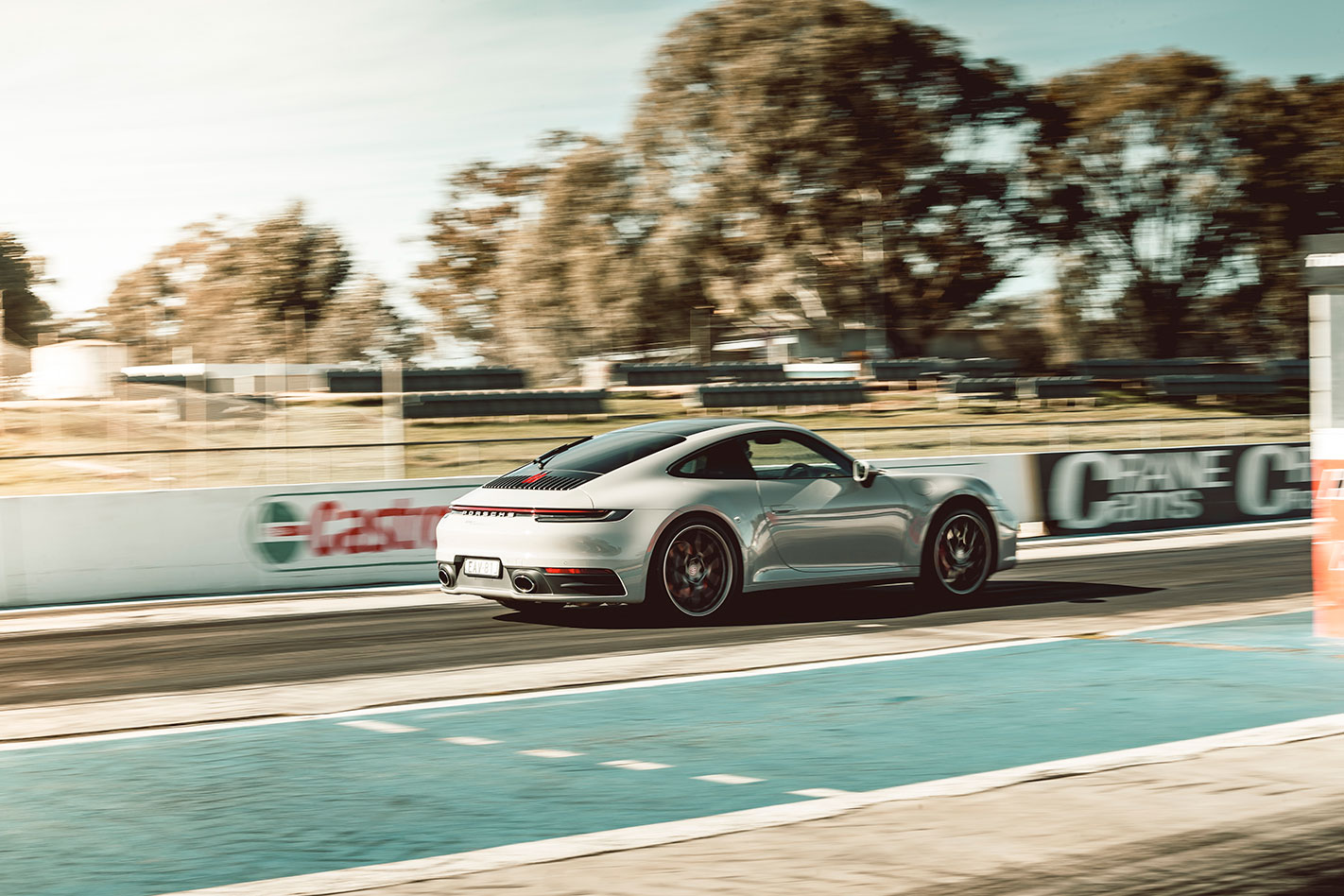
Finished in optional Crayon grey with optional RS Spyder Design alloys, it packs real visual punch. The widebody 992’s stance and detailing is a good deal more, shall we say, aesthetically considered than the soapbar 911 Carrera. An old boy stands next to it in Eildon. We make eye contact and he just smiles and shrugs, a wordless compact between us that its beauty has overmatched his vocabulary. The interior design language is similarly slick, with metal finishes, piano black and cool, understated lines. Its technology and materials are a big step on from the outgoing generation, but some testers felt the 992’s ambiance lacks warmth and soul.
There are a couple of ergonomic glitches that have been wrought in the name of understatement. The outer pair of the classic five-dial Porsche instrument pack are obscured behind the wheel, and the manettino switch no longer indicates at a glance which drive mode you’re in.
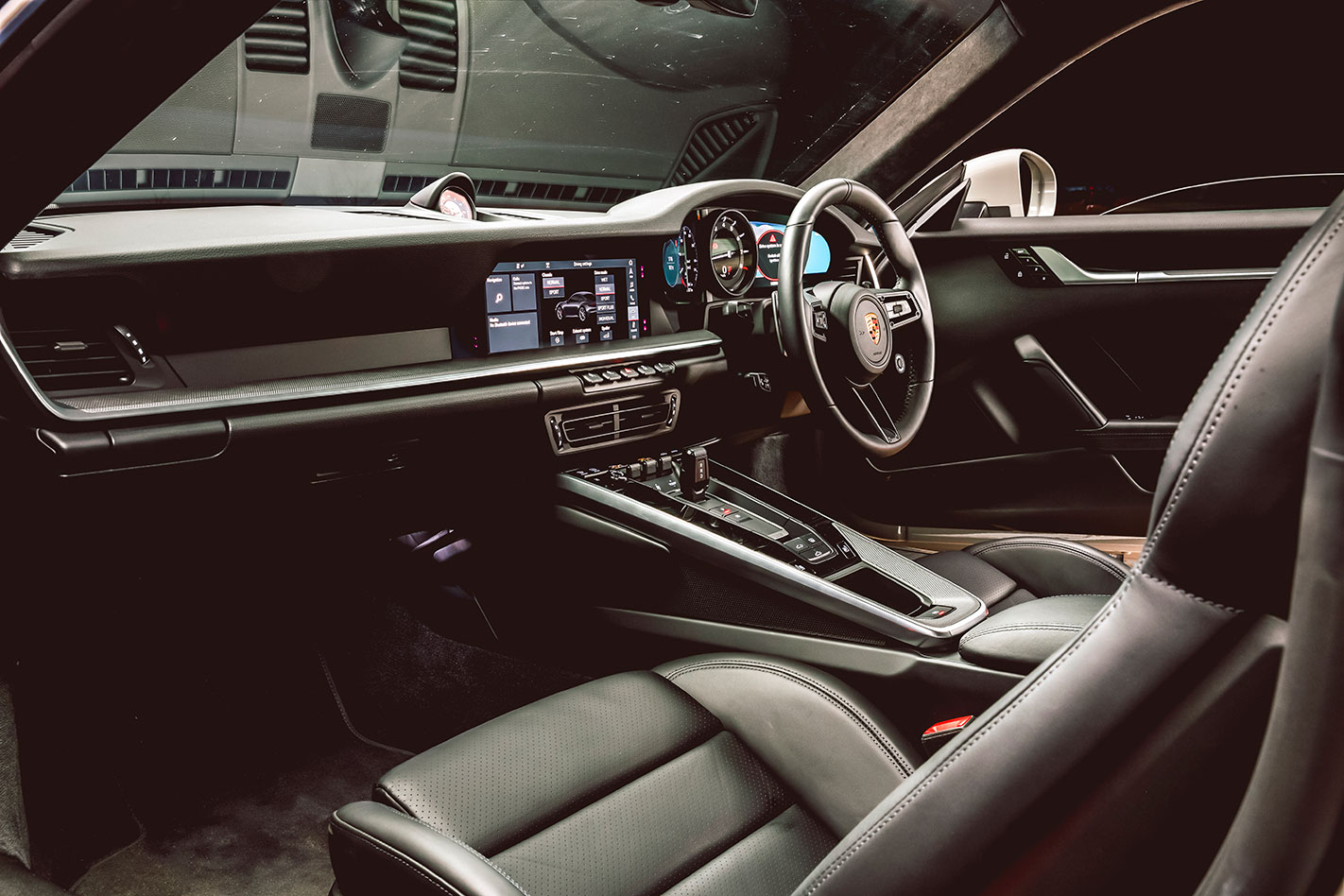
It’s phenomenally composed on a testing road, though; almost too competent at broadly legal speeds. Both engine and body control impress in equal measure. The turbocharged 3.0-litre powerplant feels like a baby GT2 motor, gutsy from 2000rpm, drenching the cabin with a barrel-chested bass note at four thousand and really starting to sing from five. Step off the gas sharply and there’s the faint twitter of wastegate chatter but the overriding impression of this engine is strength. It ladles relentless slabs of torque at its fat Eagle F1s and, in Sport Plus mode, the PDK transmission’s logic is never caught on the hop. Zuffenhausen’s robot is smarter than you.
Then there’s the car’s composure. On roads that are tight, bumpy, cold and, at times, covered in a mutinous film of something biological, the 911 not only finds traction but remains implacably planted. Most cars with this zero-hysteresis body movement feel inert and aloof, yet the 911 communicates its intentions clearly, although your meter needs to tune into its millimetric frequencies.
We’re driving on the Fraser Park Road which peters out to dirt track somewhere on Lake Eildon’s western littoral. The F-Type SVR requires considerably more user-intervention than the Porsche. The ride, which jostles and niggles on the freeway route out here, suddenly seems too soft for this tortuous route. Take a moment to reset after the 911 and it starts making sense. You need to allow a little time for the Jaguar to lean into a corner, to settle onto its springs and then it communicates clearly.
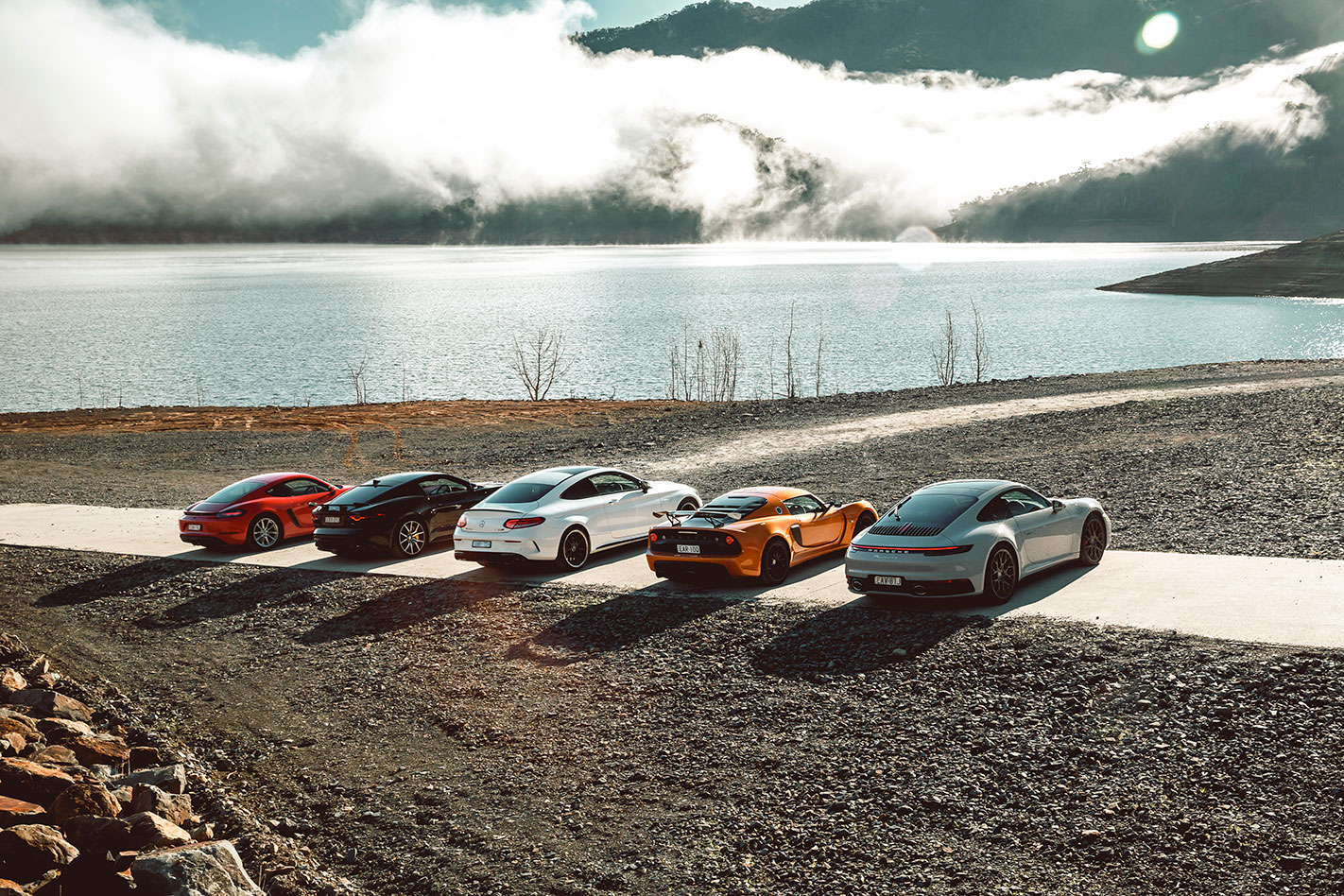
The chassis lets you feed power early, the hammering report of the 5.0-litre V8 cracking in pre-apex. It’s best to drive on the paddles as the transmission will often kick down too aggressively, but it’s a hugely rewarding process. Grip out of corners is strong and the brake pedal offers long-travel modulation, but after the 911, the steering lacks that instant sense of connection. The F-Type SVR is a fascinating thing. Brutally quick cross country, it’s exciting and effective in equal measure. It’s the most pleasant surprise of all the cars here, and it’s the perfect antidote if you find the 911 a little sterile.
The Mercedes-AMG C63 S coupe is, at 1800kg, the heaviest car here and it can never quite overcome the impost of those kegs. Its rear seats are more useable than those in the Porsche, so it earns a hall pass in some regards, but it always feels exactly what it is in the company of these specialists; namely the coupe version of a mainstream sedan. We’re huge fans of the C63, but in this extreme company, its steering is more remote, its transmission tardier, the sharp edges seemingly chamfered off its dynamic responses. Yet these ostensible criticisms morph into assets if what you’re looking for is a vehicle that’s more liveable and not as challenging as the 911. And we don’t mean challenging as the modern mealy-mouthed euphemism for difficult, but challenging as in delivering an expectation that you raise your game. The 911 goads you like that. Its steepling talents can leave you feeling a little unworthy. The Mercedes-AMG, by contrast, just wants you to have fun, however hamfisted you may be.
The driving position is a smidge too high and you look out across an expensive wheel festooned with buttons, touch pads, rotary dials and tiny digital screens dangling from the spokes. The half carbon and half Alcantara rim is fat with big, metal shift paddles tucked behind. The cabin is glitzy but never less than an event, the latter also applying to how the Mercedes-AMG tackles a challenging road.
With 700Nm under foot and a torque curve that looks like the flight deck of the USS Nimitz, it’s easy to conclude that the mighty twin-turbo V8 is going to be the dominant element. And you’d be mostly right. Despite the monster 20-inch Pilot Super Sports at the back, the C63 S struggles to marshal all that prodigious torque, the traction-control light blinking its way into three figures. Quite why AMG decided that the 520Nm C43 would be improved with all-wheel drive but not the hirsute C63 is an interesting decision. However, the need for you to be the master of how that massive firepower is deployed is also key to the C63’s engagement, and central to how it provides options of angles. Keep it tidy, quick and progressive, or chase the throttle early and feel it light up and storm out. All-wheel drive would make it faster, but almost certainly less of an event.
Traction is rarely an issue for the 718 Cayman. True, its 380Nm is almost on par with an original 911 GT3 RS but there’s a quiet authority to the way its gravelly 2.0-litre flat-four deploys those Newton metres. Compared to the histrionics of the AMG, it just digs in and powers out. The engine possesses no musicality and the sports exhaust introduces an atonal throb at idle, but it’s certainly game. While the four-pot turbo has some vocal detractors, I’ll nail my colours on now. This is a better engine than the six-cylinder 2.7 in the 981 Cayman. Faster, cleaner and more malleable in its responses, it may lack the six’s breathy overlay, but it’s long on substance. Whisper it, but it might just be a more satisfying thing than the 2.5-litre in the Cayman S.
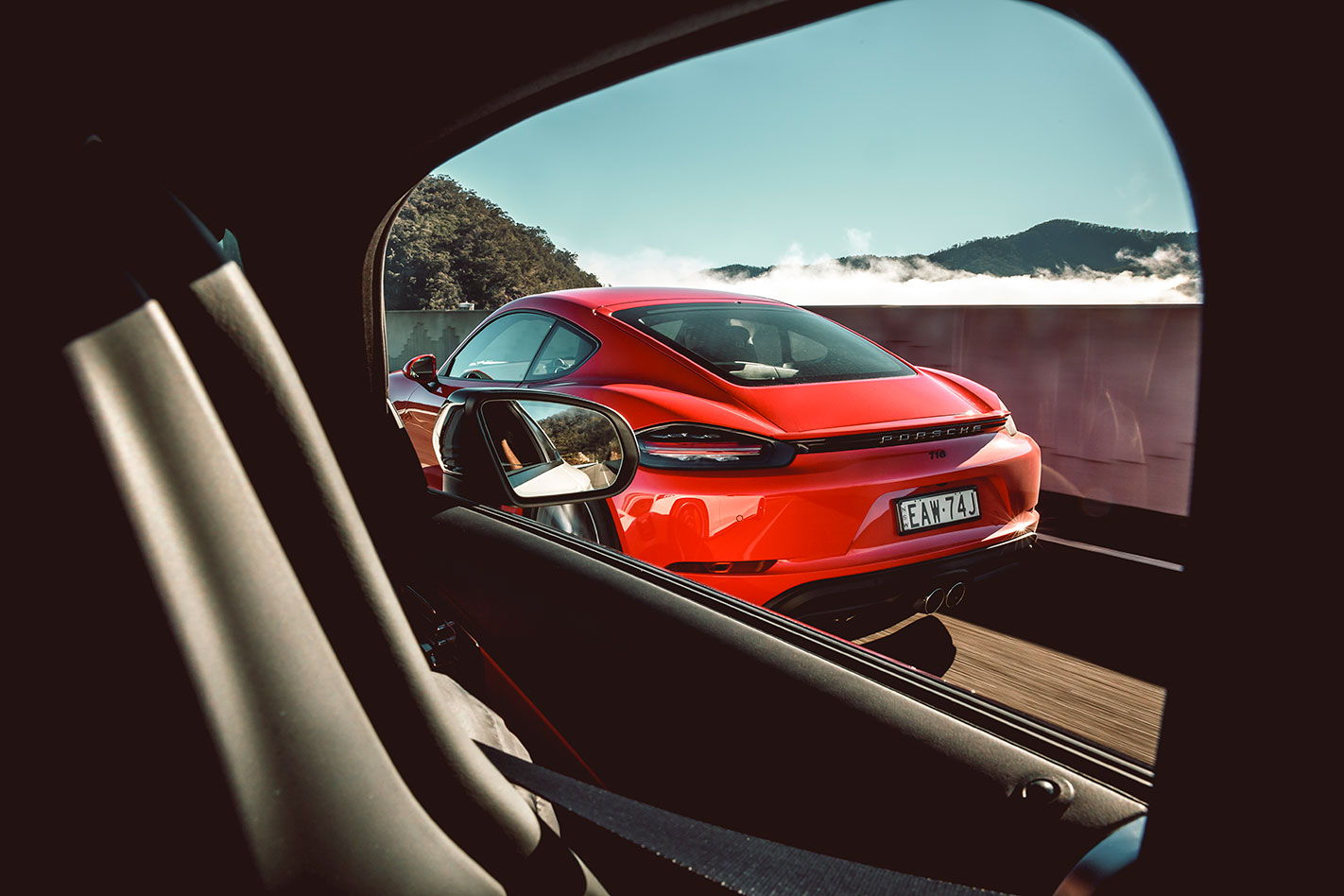
A manual gearbox would only exacerbate the aural shortcomings of the 718, but the PDK suits it perfectly. The transmission rarely tries to wring non-existent top notes from the upper registers and instead mines the rich seam of torque from 2000rpm. The PDK-equipped 718 makes peak torque slightly earlier than the manual model and with the Sport Chrono box also ticked, it’s much quicker. While numbers aren’t everything, 100km/h appears eight percent quicker in this car than in the stick-equipped version. Compared to the 911, the 718’s cabin feels – and is – from a prior generation; button-heavy and lacking the commitment to materials quality. Nevertheless, it’s a wonderfully easy thing to tune into and feel as if you’re doing a serviceable job of exploiting.
It’s difficult to tell quite how effectively you’re exploiting the Lotus Exige 410 Sport. That’s largely because you’re cackling like a loon after the first corner, just waiting for that 4500rpm threshold when the supercharged V6 erupts into an ear-splitting crescendo. Of course, this payoff comes at a price and that is posting yourself through a mailbox to get in and out of the car, being alternately frozen or roasted (there seems to be no in between) and putting up with more twitters and chirps than the merch queue at a K-pop concert.
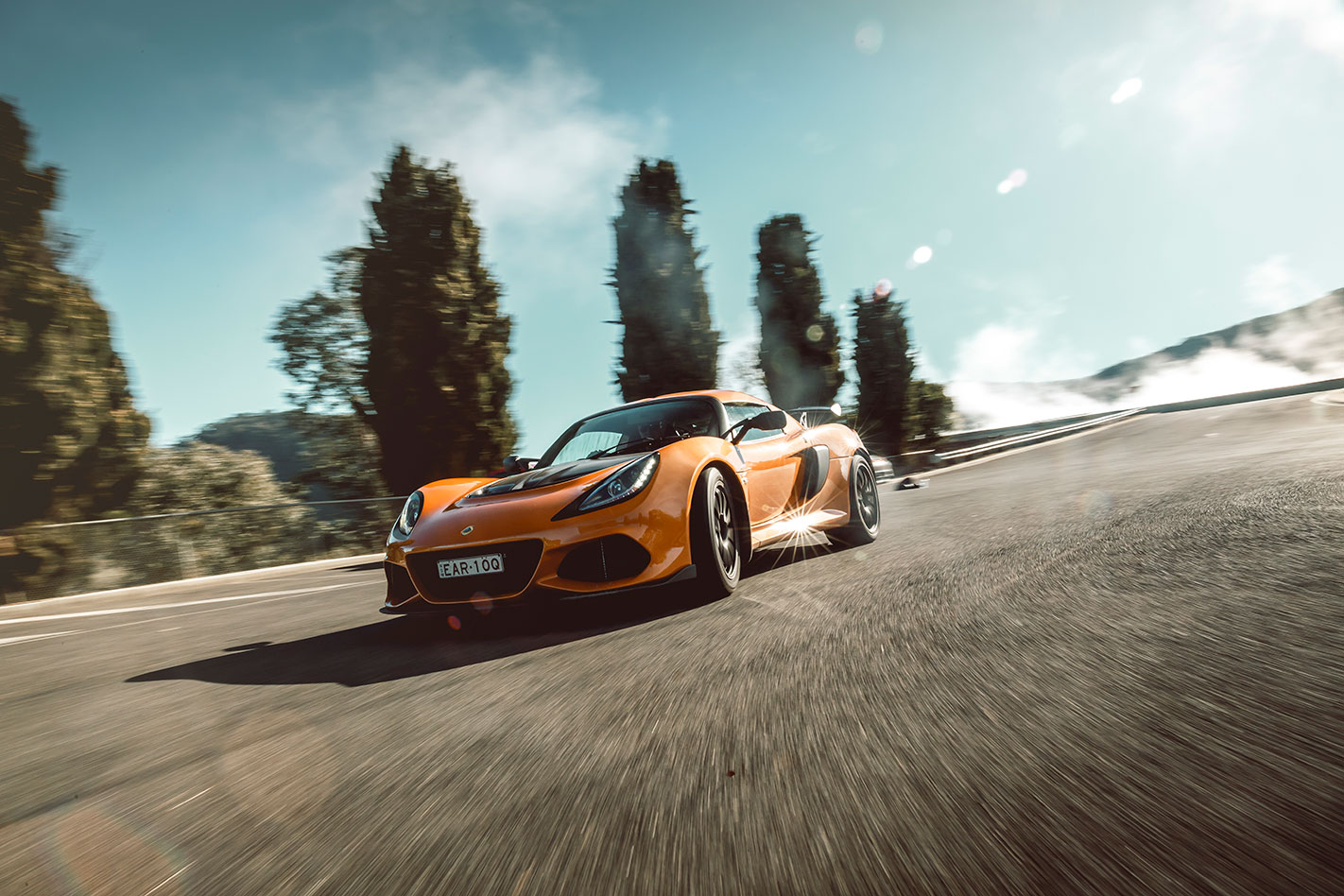
While the feral powerplant is something others can replicate, the way the unassisted steering guides you seamlessly down the first sniff of a camber, setting you perfectly into the first phase of corner entry, is the result of more than seven decades of Lotus expertise. There’s really nothing like it and it’s this polished transition into a corner that sets the tone as you pick up the throttle and drive out. The Nitron springs, three-way manually adjustable dampers, plus Eibach anti-roll bars, all add a veneer of compliance missing from the angrier Cup 430, but switching the car into Sport mode lets you realise just how much the traction control system is tapering away the excesses of your right clog. On the dragstrip it was like elevating the Exige onto four office chair castors.
With 420Nm to call upon between 3000 and 7000rpm, the Sport 410 has the flattest torque curve of any Exige. Essentially a slightly detuned version of the Cup 430, it gets a revised engine map, a new water-to-air chargecooler, an extra front radiator and a water-to-oil oil cooler in the engine bay. You get a fairly good view of that lump from the driver’s seat, too. Or at least of the supercharger and throttle cable. Reverse parking is an experience best avoided.
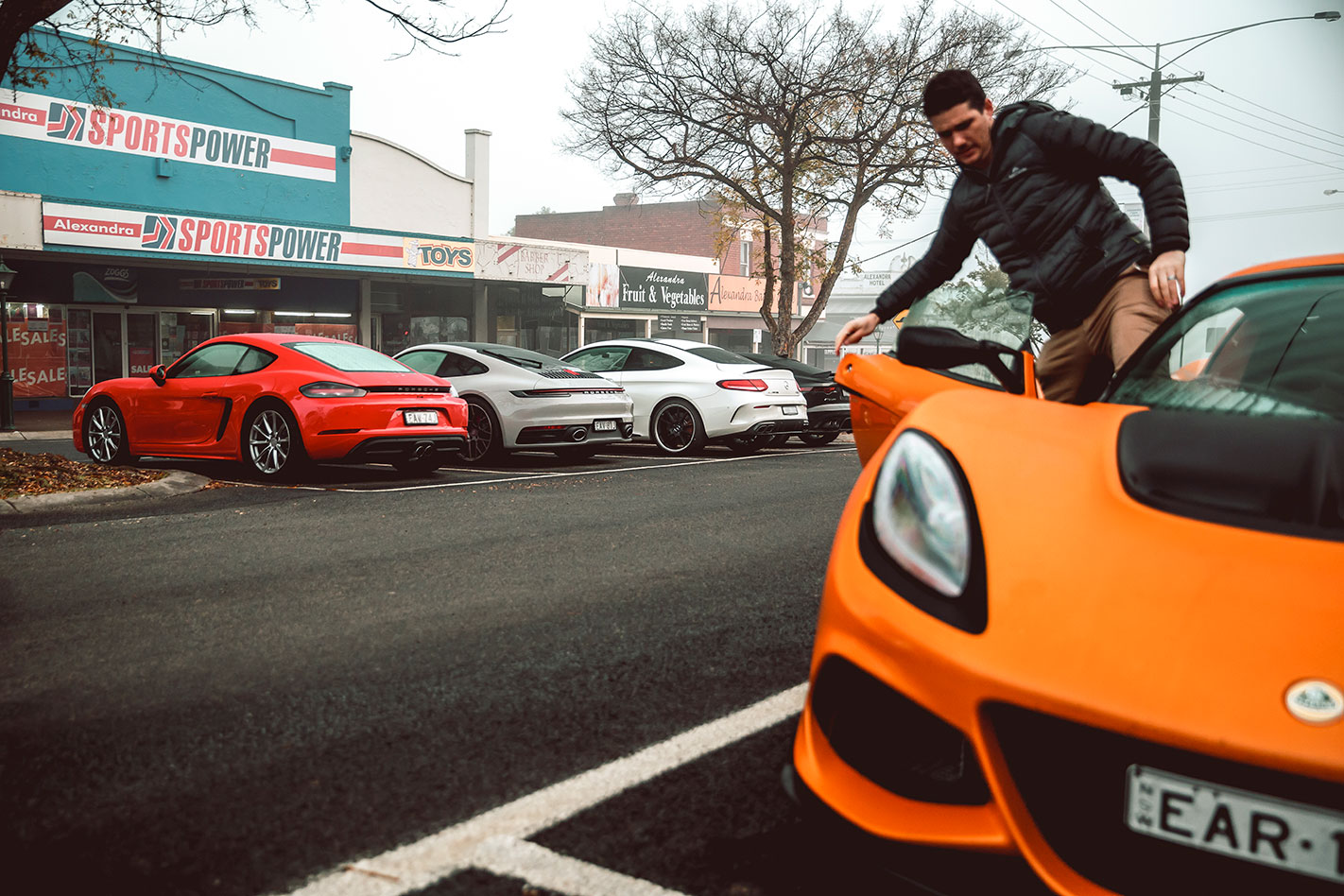
None of these four cars are unconvincing in their respective roles, each offering something different to the 911 Carrera’s excellence. The Jaguar is the more extrovert thing, and I don’t think it’s any slur to say that it feels like an extrapolation of a ’90s TVR trajectory. Loud, brutish, beautiful and unexpectedly talented once you mould to its demands, a typical SVR owner would doubtless find the 911 somewhat soulless.
The Lotus is the most exciting thing here by a massive margin and is the only car on test that possesses dynamic elements beyond the Carrera. At $159,990, it’s a significant investment for such a pared-back thing, but it doesn’t pretend to be any decathlete. Its focus is its beauty and we should celebrate the fact that such analogue cars still exist.
The Mercedes-AMG represents a genuine alternative to a 911, if you need a little more practicality and something that can be an undemanding daily driver when you need it to be. It retains an element of extremity expressed by a power delivery that can feel genuinely unhinged and a cabin that dials sense of occasion up to the max.
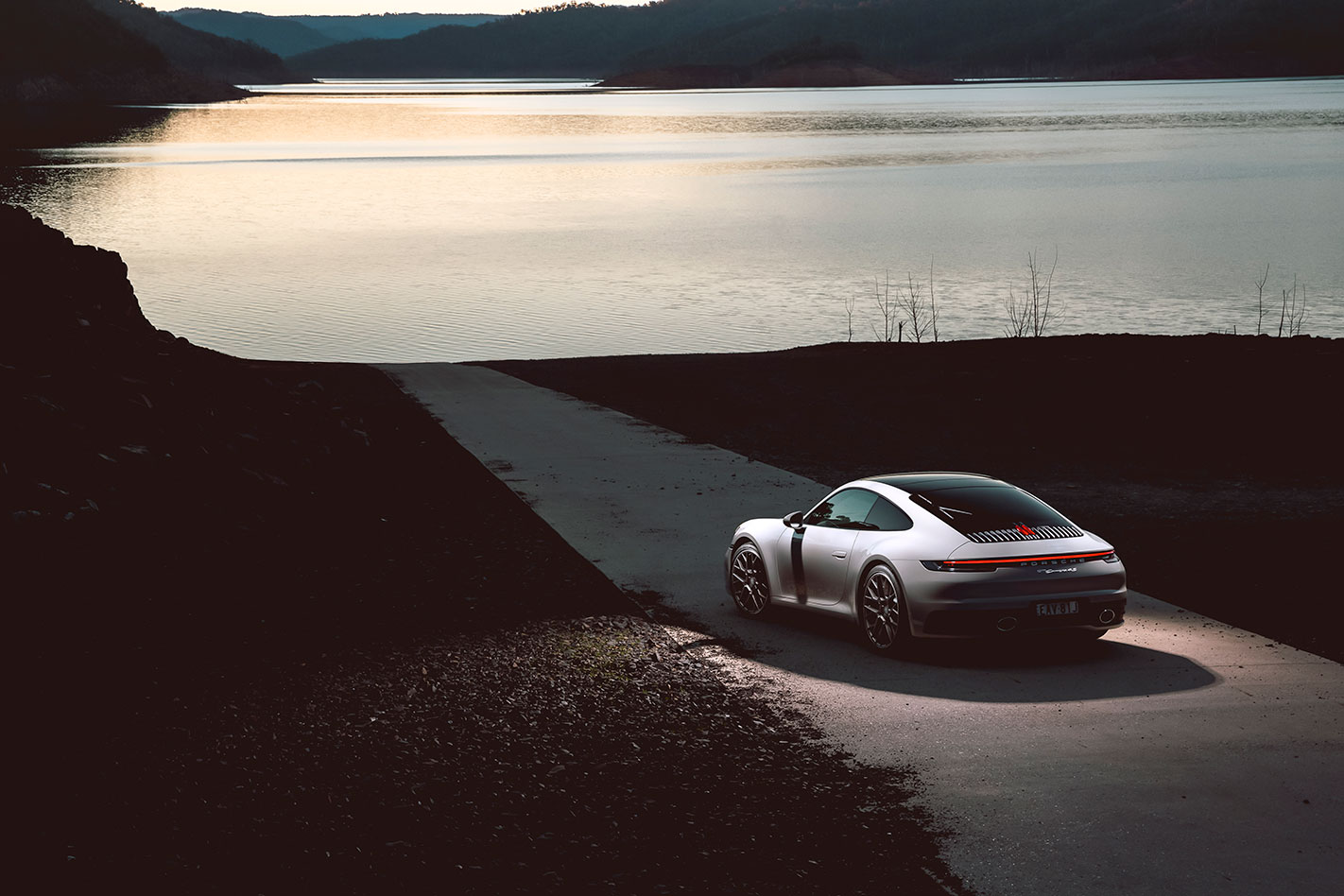
The opposite is true of the 718 Cayman. At times certain elements of its makeup can feel slightly dour. The cabin isn’t showy and the engine’s soundtrack won’t have people flocking to the pitwall at a trackday. But if you can’t run to a 911 Carrera, it makes all kinds of sense as a half-price hero. It’s purposeful, rewarding, dynamically excellent and gets us genuinely juiced about the forthcoming GT4 version.
The 911 swats everything aside with an imperious ease that is genuinely shocking. If you want the best sub-supercar, it’s so far ahead of the chasing pack that any direct comparison would be churlish. But such is its sheer insouciance, some may not warm to it. The Achilles heel of the 992 might be a certain narcissistic self-regard. Should you demand a divergent attraction with some flintier edges, we can think of four excellent claims on your attention.


